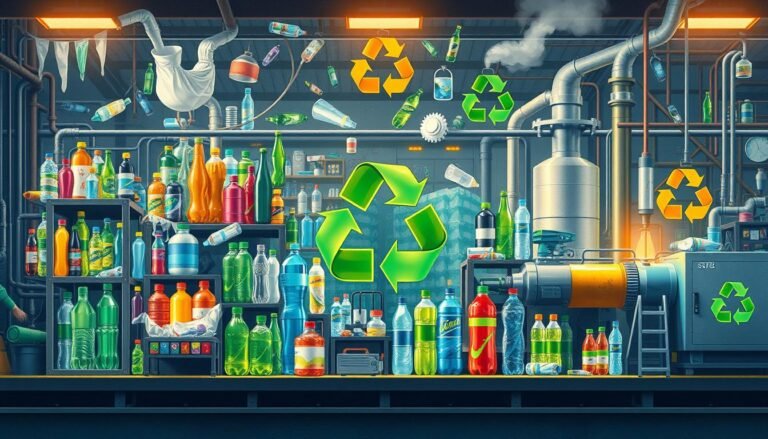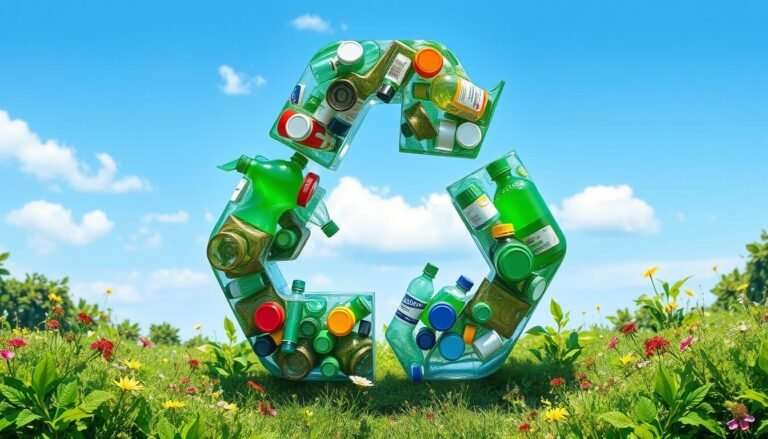Make some changes to the world environment
-
Building 3, Wanyang Innovation City, Langxia Street, Yuyao City, Zhejiang Province
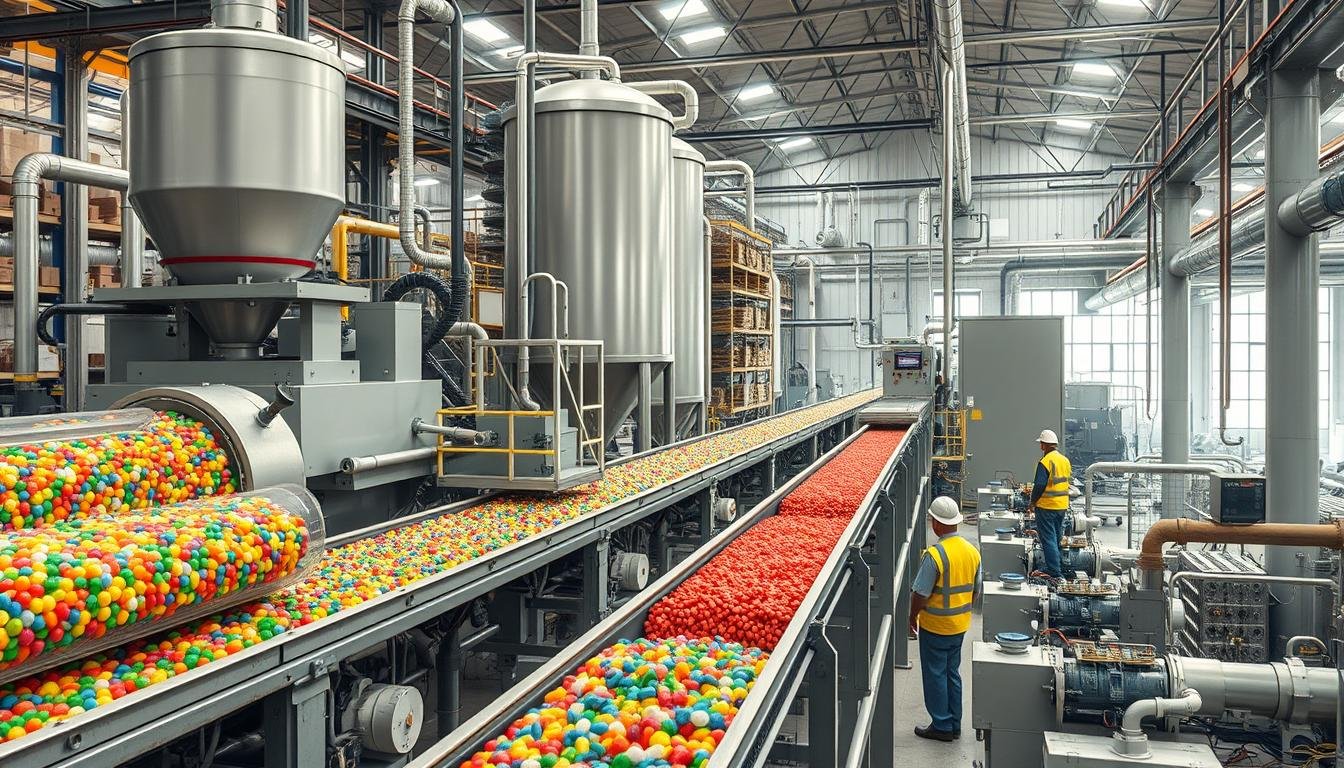
How Are Plastics Created: A Step-by-Step Guide
Ever wondered how plastics are made from stuff like crude oil and natural gas? It’s a cool mix of science and careful making. We’re going to look into how plastic is made, starting with raw stuff from the Earth to the everyday items we use.
Plastics are a big part of our lives and come from things like crude oil and natural gas. First, these materials are pulled from the Earth. Then, they go through a bunch of steps that turn them into tiny building blocks called monomers. These small pieces get linked together in a process called polymerization, making polymers. These polymers are what plastic is made of, shaped into all sorts of products through molding and extrusion. We’ll show you every step, making it easy to see how careful and precise this process is to make quality plastics.
Key Takeaways
- Plastics are mainly made from chemicals found in petrochemicals
- They start as crude oil, natural gas, and coal
- Monomers are put together in a process called polymerization to create polymers
- There are different ways of doing polymerization to make various plastics
- Today’s plastic making focuses on being efficient and making what people need
The Basics of Plastic Composition
The word ‘polymer’ comes from Greek words meaning ‘many parts’. Polymers are big molecules made by joining smaller ones called monomers. Understanding polymer creation steps helps us know how plastics are made. This includes both man-made and natural plastics. Polymers are key in making various types of plastics, which are used in many ways.
What Are Polymers?
Polymers can be natural or man-made. Natural ones are found in things like cellulose and rubber. Man-made polymers are made through chemical processes. These processes turn raw materials like oil and natural gas into useful products. This includes hard plastics like polyacetal and nylon1. There are also plastics made in large amounts for single use, like polyethylene and polypropylene. They are cheap and easy to get1.
Synthetic vs. Bio-Based Plastics
Synthetic plastics come from petrochemicals, which are from fossil fuels. They are known for being strong and lasting a long time. For example, PVC and polystyrene can be molded many times when heated2. Materials like polystyrene and ABS are useful for many things like appliance covers and helmets1. On the other hand, bio-based plastics are made from things like corn starch. They are becoming popular for being good for the environment. Knowing how polymers are made helps understand the differences in these materials.
Raw Material Extraction
The first step in making plastic materials is getting the raw stuff. We mainly get these materials from crude oil and natural gas. These substances are full of hydrocarbons. They need a lot of work to get ready for plastic making.
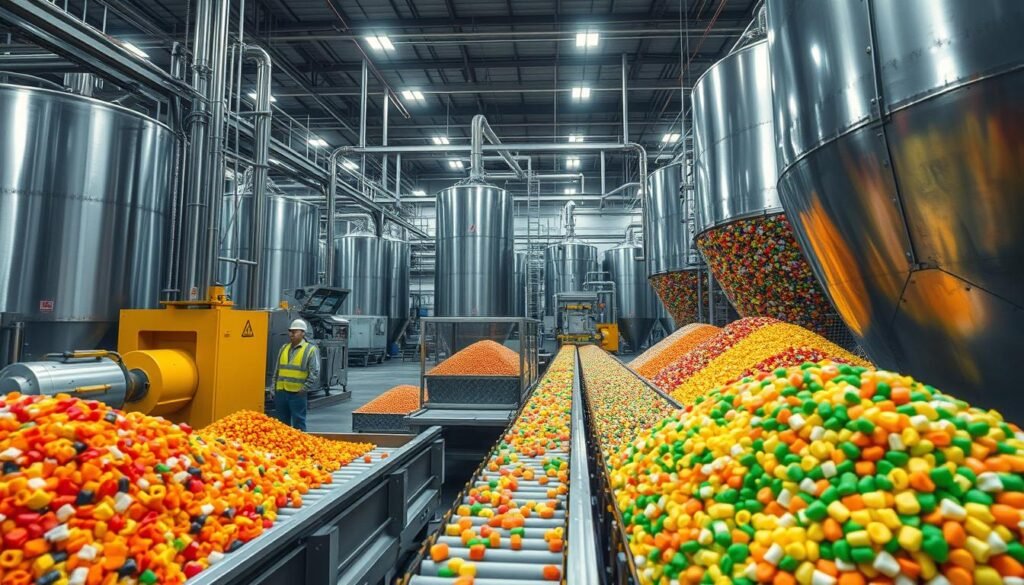
Sources of Raw Materials
Crude oil is super important for making plastics, making up 99% of the materials used3. It has to go through many steps to be ready for use in plastic making3. Utah plays a big role in the U.S., being the 11th top oil producer. It has five refineries working on over 150,000 barrels daily3. Also, polyethylene comes from ethylene. It’s a plastic used a lot in packaging4.
Environmental Impact
Getting and refining raw materials can hurt the environment. Drilling can harm animal homes, and spills can pollute5. In Utah, for example, crude oil is a big part of what the state uses for energy. It makes up 14% of Utah’s energy and 32% of what people use3. The plastic industry is trying to be better. They’re using bioplastics made from plants5. This helps cut down the harm to our planet. By doing this, we can make plastic in a cleaner way.
The Refining Process
The refining process is a key step in making plastics. It turns crude oil into the parts needed for different plastic items. This process checks the quality of materials and how well they can be made into plastics.
Crude Oil Transformation
Crude oil is a mix of many hydrocarbons. It goes through many steps to get the parts needed for making plastics. First, the oil is heated until it turns into vapor. Then, as it rises in the distillation column, it cools down and changes back into liquid. This step creates important materials like naphtha, vital for the plastic-making process6.
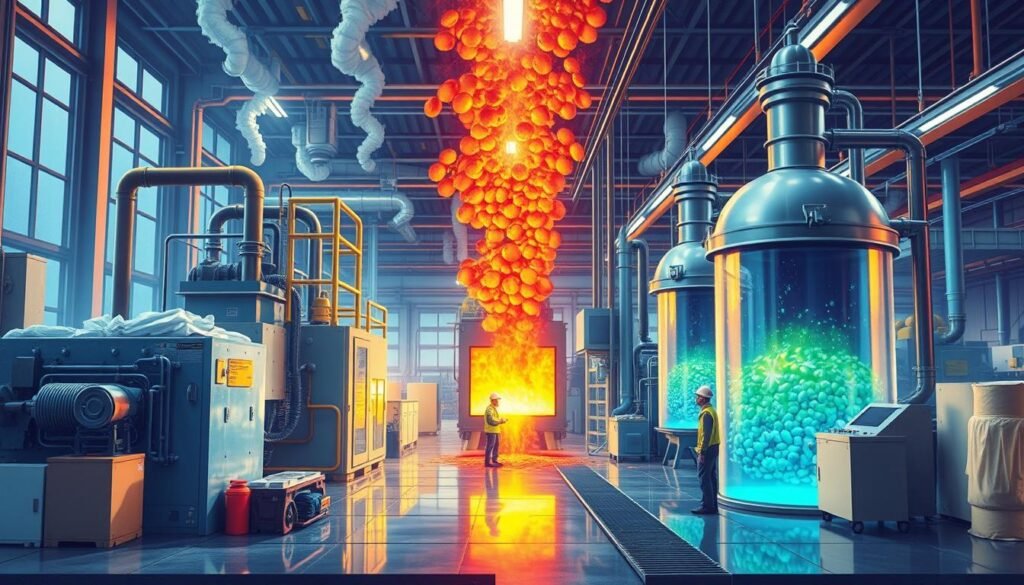
Production of Naphtha
Naphtha comes from distilling crude oil and is key for making plastic. It’s used as the main material to create plastic pieces. When heated in a steam cracker, it breaks down into smaller parts. These smaller parts are used to make polymers needed for different plastic products6.
The making of naphtha is just the beginning. The small parts, or monomers, are then turned into long chains. This step makes the basic structure for plastics. This allows us to make materials that are strong and flexible. Knowing how refining works helps us make better plastics. This way, we can make sure we’re efficient and not harming the environment.
Polymerization: Creating the Basic Structure
Polymerization is key in making many kinds of plastics. It changes simple molecules into complex polymers, changing their properties and uses. There are two main ways to do this: addition and condensation polymerization. Each process has its own benefits for the types of polymers it makes.
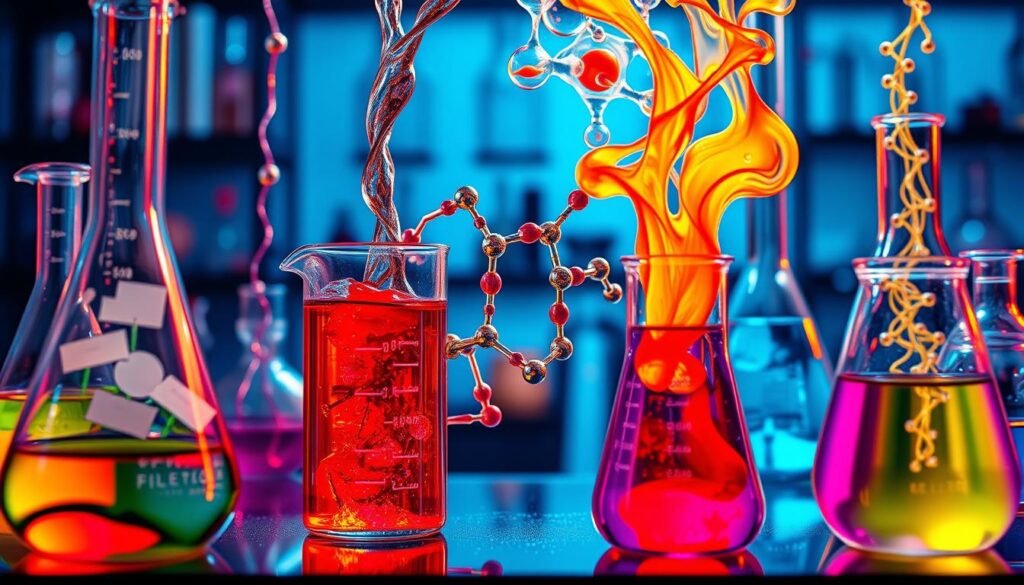
Addition Polymerization
In addition polymerization, monomers join together one after another. This is how polyethylene types like HDPE, MDPE, and LDPE are made. With this process, polymers can reach very high molecular weights7.
Polymers from addition polymerization, like polyethylene, are used in bags, wire insulation, and bottles8.
Condensation Polymerization
Condensation polymerization removes small molecules like water as it goes. It’s important for making PVC and PET. The industry uses catalysts and new reactor designs to make this better7.
This method makes materials that resist chemicals, used in food wraps and floor coverings. It needs cooling to keep reactions safe7.
The variety of polymers from both processes shows how vital they are. They impact many manufacturing techniques. Knowing more about these methods helps us improve how plastics are made. Creating polymers thus plays a big part in innovation7.
The melt-flow index of polymers affects how they’re shaped into products. Adjusting the reactor settings lets us control polymer quality. This precision is crucial in modern polymer making7.
Realizing polymers’ varied properties, like resistance to chemicals, shows why their making is so tailored. The polymer field keeps innovating, meeting the needs of many industries8.
How Are Plastics Created: A Step-by-Step Guide
Making plastics is an intricate process that turns raw stuff into what we use daily. It happens in many steps that change basic materials into versatile products. Let’s dive into these steps and see how technology has improved them.
The journey begins with getting raw materials. Plastics mostly come from fossil fuels like crude oil and natural gas. These go through a refining process to make naphtha, a vital material for making plastics9. This refining is key to getting ready for the next big step: polymerization.
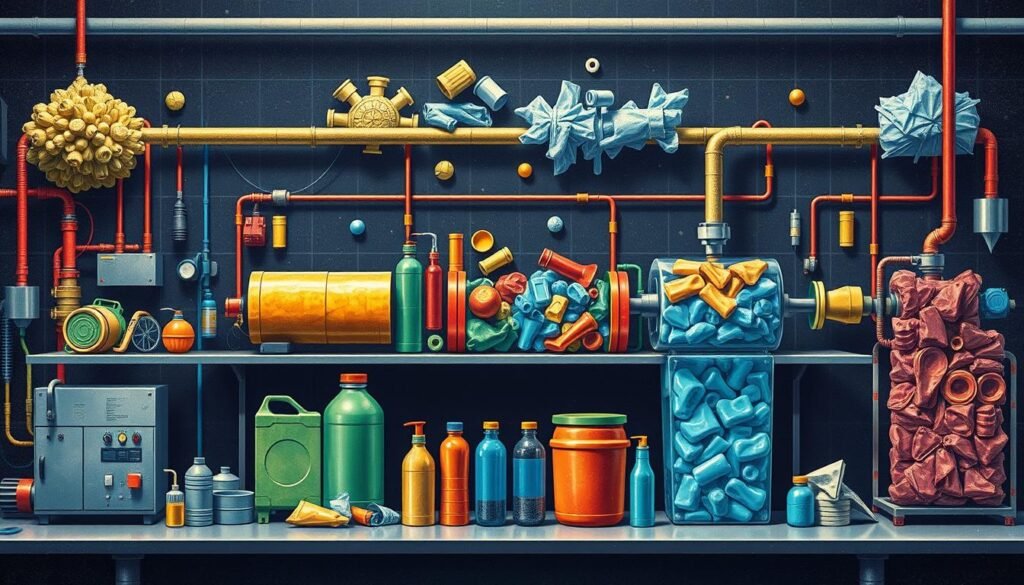
Polymerization is where things get interesting, turning feedstocks into polymers. There are two main ways this happens: addition and condensation polymerization. In addition polymerization, catalysts help monomers like ethylene and propylene bond together9. For condensation polymerization, monomers connect by kicking out molecules, like water9. This step is crucial as it forms the backbone of plastics.
After polymerization, we mix the polymers with additives. This is called compounding, and it tweaks the plastic’s properties. Compounding makes sure the plastic will work well for its final use. Also, thermoplastics can be melted and solidified many times without harm10.
In shaping plastics, two common methods are used: extrusion and injection molding. Extrusion squeezes melted plastic through a mold to create shapes. Injection molding pushes molten plastic into a mold for complex designs. Both need special equipment to work right.
Flying Tiger provides tools needed for making plastics. These tools help make the production steps smoother and ensure the plastic is top quality. To learn more about making plastics, check out the full guide at this link.
New technologies like 3D printing and CNC machining have upgraded plastic making. 3D printing uses different materials for various needs, including ABS and PLA10. CNC machining is great for making precise parts in low volumes out of many plastics10.
Knowing how plastics are made helps us value the progress and efficiency in the industry today. Each step, from extracting materials to final touches, is vital. Together, they give us the wide range of plastic items we depend on every day.
Compounding and Processing
In making plastic, compounding plays a key role. It mixes polymers with additives to get the right features. This process is crucial for making custom plastic that meets special needs. It boosts qualities like color, strength, heat resistance, and lastingness11.
Melt Blending
Melt blending is vital in compounding. It heats and melts base polymers. Then, it mixes in additives and reinforcements in an extrusion machine. This step makes additives spread out evenly, improving the plastic’s properties12.
The better mix boosts mechanical, thermal, and electrical qualities. These qualities can be adjusted for different uses. For example, melt-blended plastics are highly valued in the automotive, electronics, and packaging sectors. They are chosen for their enhanced toughness and ease of use13.
Pelletizing
After melt blending comes pelletizing. This turns the mixture into even pellets. It’s done by pushing molten plastic through a die and chopping it into pellets. These pellets are a key material for making various plastic products. They assure uniform quality in the final items12. Notably, companies like Plastic Service Centers stock a wide range of these compounds. Also, Star Plastics is known for making custom-colored pellets quickly, ensuring customer satisfaction and timely delivery11.
The care taken in compounding and processing is key to making specific plastic materials. These steps help in creating new plastic solutions that meet the demands of different fields. They also aid in making better use of recycled and bio-based polymers, leading to advancements in plastic making and helping the environment13.
| Industry | Applications | Primary Benefits |
|---|---|---|
| Automotive | Weather seals, body panels, dashboards | Weight reduction, fuel efficiency |
| Electronics | Heat-resistant, flame-retardant components | Electrical insulation, reliability |
| Packaging | Bottles, containers, UV-resistant films | Barrier qualities, mechanical strength |
| Construction | Window profiles, insulation materials | Energy efficiency, sustainability |
| Healthcare | Surgical tools, medical devices | Biocompatibility, chemical resistance |
| Consumer Goods | Toys, furniture, sporting goods | Performance, durability, affordability |
The Injection Molding Process
The injection molding process plays a key role in making lots of plastic parts quickly. It’s used in many areas like cars, gadgets, and health tools because it’s fast and not too expensive. This method works better than others for making lots of detailed parts.
Design for Manufacturability (DFM)
Design for Manufacturability (DFM) is the first step where we make sure the part’s design is good for making it easily. We try to keep the walls the same thickness to avoid problems and add slopes for easy removal from the molds14. Picking the right plastic and add-ons is also crucial for the part to work right14.
Prototyping
Next, in the prototyping phase, we make early versions to fine-tune everything. We use quick methods to check our designs and decide on the best metal for the molds15. This stage includes testing with different plastics to see which one works best14.
Production Phase
Then, in the production stage, we fill molds with melted plastic to make the solid parts. We can make up to 10,000 parts every day, depending on how complex and big they are15. Using different ways to fill the molds helps make the process cheaper and simpler14.
Secondary Operations and Post-Production
After making the parts, we do extra steps like finishing and putting parts together. We use special methods to add more materials, which makes the parts work better and feel nicer14. These steps help make sure the final products are great and meet all the rules.
Every step, from DFM to the final checks, needs to be done very carefully. This is how we make sure everything we make is of high quality.
Plastic Manufacturing Methods
Plastic manufacturing uses different methods apart from the popular injection molding. One method is extrusion. It’s very adaptive, making continuous items like pipes, sheets, and profiles. This happens by pushing melted plastic through a mold.
Blow molding is key for making hollow items, such as bottles and containers. Especially, injection blow molding is for thin-walled items like disposable cups or bottles16. Rotational molding is great for big, hollow shapes like canoes, tubs, or tanks. It promises strong and smooth surfaces16.
Thermoforming is budget-friendly, perfect for simple shapes. It’s often used for plastic cups, lids, boxes, and parts for cars16. The process heats a plastic sheet until it’s bendable, then shapes it over a mold. Meanwhile, compression molding fits for soft, thin items like rubber keypads, gaskets, and O-rings16.
Moreover, 3D printing and CNC machining highlight the variety in making polymers. 3D printing is fast, less than a day, fitting for customized parts in small to medium amounts17. CNC machining also has a short lead time and works for all volume levels, perfect for intricate designs17.
Learning about these plastic-making methods opens up the vast options in the industry. Using different techniques improves work, encourages new ideas, and adds flexibility to making goods.
There are more than 10,000 types of plastic resins available, led by ten main groups. These groups include Polyamide, Acrylic, Polycarbonate, POM, Polystyrene, ABS, Polypropylene, Polyethylene, Polyurethane, and Thermoplastic Rubber16. These materials show how adaptable and varied the plastic industry is, showcasing the creativity in making polymers.
Conclusion
Our look into plastic creation shows its key role in our life. Every step from getting raw materials to making the final product involves science and innovation. In just 50 years, we’ve seen plastics become essential, with production jumping a lot during World War II18. Then, plastic use in the U.S. grew by 300%, highlighting its big role in tough times18.
We also face the challenge of keeping our environment safe. The issue of plastic waste is huge, with 8 million tonnes going into the ocean each year. By 2050, we might have more plastic than fish in the sea19. It’s crucial to focus on recycling, even though only a small part of plastic is recycled more than once19. The new bio-plastics could help reduce the bad impact on the environment. Learn more here.
As we move forward, keeping up sustainable habits in the plastic industry is important. Using new ways and making big changes can help us use plastic without hurting our planet. The story of plastic is really about human creativity and the push for a better, greener future.


